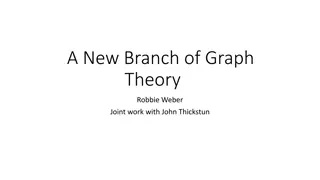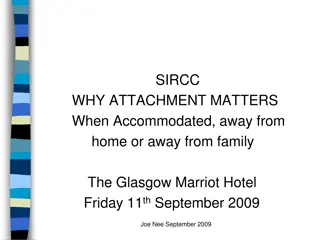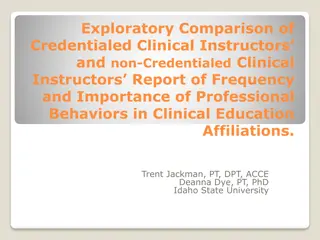Insights into Attachment Theory and Clinical Implications
Explore the clinical implications of attachment theory, as discussed by Miriam Steele and Bowlby, highlighting how early attachment patterns persist into adulthood and influence relationships. Learn about the Strange Situation test, Adult Attachment Interview, and intergenerational patterns of attachment, shedding light on the impact of childhood experiences on adult relationships.
Download Presentation

Please find below an Image/Link to download the presentation.
The content on the website is provided AS IS for your information and personal use only. It may not be sold, licensed, or shared on other websites without obtaining consent from the author.If you encounter any issues during the download, it is possible that the publisher has removed the file from their server.
You are allowed to download the files provided on this website for personal or commercial use, subject to the condition that they are used lawfully. All files are the property of their respective owners.
The content on the website is provided AS IS for your information and personal use only. It may not be sold, licensed, or shared on other websites without obtaining consent from the author.
E N D
Presentation Transcript
Attachment Theory and Research: Clinical Implications Miriam Steele Department of Psychology New School for Social Research New York
Bowlby on persisting models it seems necessary to postulate that whatever representational models ofattachment figures and of self an individual builds during his childhood and adolescence, tend to persist relatively unchanged into and throughout adult life. As a result he tends to assimilate any new person with whom he may form a bond, to an existing model and often continue to do so despite repeat evidence that the model is inappropriate. Similarly he expects to be perceived and treated by them in ways that would be appropriate to his self models and to continue with such expectations despite contrary evidence.
What can attachment theory and research bring to work with child maltreatment? A model of affect regulation A broad evidence-based knowledge of parents and children A window upon the inner world ( a move to the level of representation via surprising the unconscious ) A focus on resolution of trauma and loss A high regard and respect for parents and children
Ainsworths Strange Situation Activate the attachment system via separation Activate the exploration system via novel playroom Observe the child s strategy upon reunion Secure (65%) Avoidant (20%) Resistant (10%) Disorganized (5-10% in non- clinical populations but up to 80% of maltreated infants)
Adult Attachment Interview (George, Kaplan & Main, 1985) What happened? 5-adjectives for early relationship w/mother and w/father Emotionally upset? Physically hurt? Separated? Rejected? Abuse? Loss? What do you make of it? Why do you think your parents behaved the way they did? Has childhood influenced the kind of person you are today?
Intergenerational patterns of attachment Dismissing (minimizing) Avoidant Autonomous (balanced and valuing) Secure Preoccupied (maximizing) Resistant Unresolved re past loss or trauma (absorption in grief) Disorganized
Prenatal classification of 96 mothers and 90 fathers on AAI by infant-mother (12 mos) & infant-father attachment (18 mos) Steele, Steele & Fonagy, 1996, Child Development
Metacognition ----> Reflective Functioning an understanding of the nature of mental states a relational perspective (mental states in one influence mental states in the other) a developmental perspective re the there and then an appreciation for demands of the current context, or the here and now the reparation in the rupture and repair cycle
Indicators of past deprivation Prolonged separation (>3mos) from parents before age 11 Single - parent family Low SES Paternal unemployment > 3 months Severe illness in mother or father Boarding school experience before age 11
Frequency of secure and insecure infant-mother classifications grouped by mothers past experiences of deprivation and present reflective-functioning (Fonagy, Steele, Steele, Higgitt & Target, 1994, Emmanuel Miller Lecture, Journal of Child Psychology & Psychiatry).
Attachment Representations and Adoption Study Miriam Steele Jeanne Kaniuk Jill Hodges
Attachment representations in adoptive families (AFC/GOS/Coram Family Adoption Service) N=65 late-adopted children N=43 early adopted
Adult Attachment Interview Distributions Typical Population Unresolve d 15% Dismissin g 20% Pre- Occupied 10% (Steele et al, 2008) (Van Ijzendoorn & Bakermans-Kranenburg 2008 (N=1012) Secure 55%
Pre-placement characteristics and adopters attachment status: Implicit knowledge of the social worker? Mothers with autonomous-secure interviews were more likely to be have children placed: who were abused at a younger age had a higher incidence of physical abuse
Parent Development Interview modified after Aber, Slade, et al 1985 View of the child - thumbnail sketch of what child is like? -what was child like when first placed? View of relationship -5 adjectives to describe child -time last week you did/did not really click Self as parent -most joy, most pain in being a parent -where do you turn for emotional support Child s adaptation to placement -how affectionate, over-friendly, response to distress
Coding of Parent Development Interview (Henderson, Hillman & Steele, 2003) Mother s representation of self - joy, anger, disappointment/despair, hostility - competence, confidence, need for support, level of child focus, knowledge of attachment Mother s representation of the child -happy, angry, shows affection, is rejecting, is controlling/manipulative, is over-friendly, is creative in play, is frustrated with engagement Narrative style of mother -richness of perceptions, vivid description, reflective ability, overall coherence
Joanne when asked Can you describe a time in the last week when you really clicked with Sam? We were gardening yesterday, and I found this big, fat green bug, in the soil and brought it over for him to see it, and he really liked it. And he likes wood lice, which I can t stand, and he said Feel it on your hand Mummy, it s all tickly . And so I let him put a wood lice on my hand, which was against my better judgment, and he really liked the fact that it was running all over me.
Julia when asked What do you like most about Tom? Tom is a little charmer. You know, I mean when people look at him, you know, they see what appears to be a happy little child. He s far from being a happy little child. He needs statementing. The previous borough got out of that. Hopefully the borough that we re in, will do that for him. But just say, you know, the worst scenario and, you know, he didn t do very well at school and that, he could probably get by in life because of his charm. Once he got to the stage where he could use it to his own good, whereas at the moment he s not able to reason or anything like that.
Mothers rated as autonomous-secure (vs insecure) and their responses to Experience of Parenting Interview at placement: More: -joy, competence, child focus, reflection on relationship, richness, and vividness of description Less: -anger, despair
Mothers rated as autonomous-secure (vs insecure) and their responses to Experience of Parenting Interview at one- year follow-up : More: guilt, child is rejecting But also more: child focus, richness, confidence
Mothers rated as autonomous-secure with regard to attachment when interviewed about their experience of parenting at two year follow-up: Less: guilt More: joy, competence, confidence knowledge of attachment, reflection on relationship, and richness of perception coherence: secure (n=42) group mean=3.4, sd=.96 and insecure (n=13) group mean=2.3, sd=.66,
Mothers rated as Unresolved with regard to Loss/Trauma when interviewed about their Experience of Parenting at placement: More: -need for emotional support, disappointment/despair, hostility Less: -joy, competence, confidence, level of child focus, knowledge of attachment, reflection on relationship, coherence, richness of perceptions
Parent Development Interview responses in relation to number of caregivers in child s history Those with more caregivers prior to placement: were reported by their mothers to have higher levels of aggression, more controlling behavior, are less affectionate and more rejecting Mothers report higher levels/degrees of anger, greater needs for emotional support, lower confidence, & lower degrees of warmth One year on: more caregivers are associated with more aggression and frustration in the children Two years later: children with more caregivers do not show differences
Correlations between childs age and Experience of Parenthood Interview (PDI) at placement For full late-adopted sample, if child was older at placement, mother is more disappointed, child is less happy, & less affectionate For insecure mothers, if child was older M is more angry, less warm and child is thought to be less affectionate For secure mothers, child s age at placement was unrelated to mother s experience of parenting
Story-stems used to elicit childrens emotion narratives MacArthur Network (Emde, Bretherton, Oppenheim, 2004) Children presented routine conflict dilemmas, then are asked to show me and tell me what happens next? MacArthur Spilled Juice Narratives are coded for content and process
4 internally consistent sets of themes were identified, at each time point in each sample through data reduction of the ratings made of over 3000 story-completions Security Child Seeks Help, Siblings/Peers Helping, Realistic Mastery, Adult Provides Comfort, Adult Provides Help, Adult Affectionate, Limit Setting, Coherent Aggression, Acknowledge Distress of Child and Adult, Domestic Life Intense aggression Child Endangered, Child Injured/Dead, Excessive Compliance, Adult Unaware, Adult Actively Rejects, Adult Injured/Dead, Extreme Aggression, Neutralisation, Throwing Away/Out Disorganized/controlling Child Parents/Controls, Catastrophic Fantasy, Bizarre/Atypical Material, Bad to Good Shifts, Magic Omnipotence Defensive avoidance No Engagement, Disengagement, Initial Aversion, No Closure, Premature Foreclosure, Changes Constraints, Avoidance of Conflict, Denial of Distress
Story completion themes in the late adopted group over first 2 years of placement: Year Group Effect 4.500 3.438 Secure Aggression Disorganised Avoidant 2.375 1.313 0.250 Year 1 Year 2 Year 3 (Wilks Lamda=.80, F=9.35, df=8,63, p < .001)
Defensive avoidance themes of maltreated children as a function of adoptive mothers AAI insecurity versus security AAI status (Roy s Largest Root F=3.29 (4,138) p < .005) 1.50 1.25 AAI Insecure 1.00 AAI Secure 0.75 0.50 Year 1 Year 2 Year 3 Year group by Maternal AAI interaction, F=4.32, p < .05
Defensive avoidance themes of maltreated children as a function of adoptive mothers unresolved versus resolved AAI status 1.50 1.25 AAI Unresolved 1.00 AAI Resolved 0.75 0.50 Year 1 Year 2 Year 3 Year group by Unresolved AAI interaction, ANOVA F=3.48 (df 2, 168) p < .05
Did collecting Adult Attachment Interviews from the adoptive fathers, as well as the mothers, provide added value?
Childrens summary insecure aggression and disorganization scores grouped by interaction of parents AAI security 2.75 2.50 2.25 2.00 1.75 Aggression Disorganized 1.50 1.25 1.00 0.75 0.50 Neither Secure Mother only Secure Father only Secure Both Secure (Roy s Largest Root F=4.19 (4,137) p < .005)
On the persistence of old models Why do the secure themes increase for all children but aggressive and disorganized themes remain stable over time for children placed with two insecure caregivers? New models of self with others built up in treatment do not obliterate old models. They are build up alongside the old: the potential activation of the old remains: particularly under conditions of stress (Anne Hurry, 1998, pg. 51)
Mary Main (1990) comments that at times of distress the secure infant has only one consideration in mind, how to alert the parent for proximity. The insecure infant in contrast, has to also consider the parent s response. Tronick (1997; pg.65) hypothesises that reparation of interactive errors is the critical process of normal interaction that is related to developmental outcome rather than synchrony or positive affect per se. Bowlby s earliest writings on affect regulation and specifically on the ambivalence that must exist in every parent, asserts that insecure parents find the child s negative emotions, especially hatred directed towards the parent, the most difficult and meet such displays with a similar matched negative response, an averted gaze, withdrawal or display of concomitant anger (Bowlby, 1956/1979). How much more so are these comments on parenting must be relevant to the caregiver of the child in placement .























